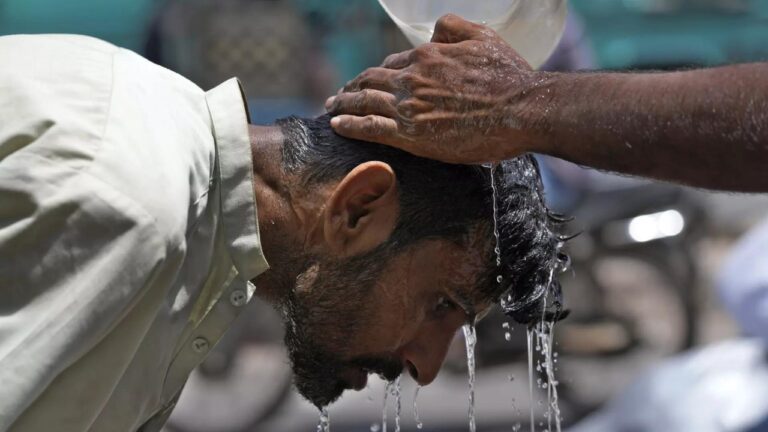ISLAMABAD: Pakistani authorities on Tuesday urged people to stay indoors as the country faces a heat wave, threatening dangerously high temperatures and another round of glacial flooding.
Pakistan’s most populous province, Punjab, has closed all schools for a week due to the heat, affecting an estimated 18 million students.
“The sweltering heat is likely to continue this month,” said Zaheer Ahmed Babar, a senior official at the Pakistan Meteorological Department. He added that temperatures could be up to 6 degrees Celsius (10.8 degrees Fahrenheit) above the monthly average. Babar said temperatures could exceed 40 degrees Celsius (104 degrees Fahrenheit) in many parts of the country this week.
This is the latest climate-related disaster to hit the country in recent years. Melting glaciers and increasing monsoons caused devastating floods that at one point submerged a third of the country.
Pakistan had its wettest April since 1961, with more than double the normal monthly rainfall, according to the National Meteorological Center. Experts say last month’s heavy rains killed many people and destroyed property and farmland, but climate change is causing the country to experience even more heavy rains.
Pakistan is still trying to recover from $30 billion in losses caused by catastrophic climate change floods that killed 1,739 people in 2022.
Health officials said hospitals were directed to set up emergency heatwave response centers to ensure quick treatment for people affected by the scorching temperatures.
According to doctors, heatstroke is a serious illness caused by a sudden rise in body temperature due to sweltering heat, and can lead to unconsciousness. Severe heatstroke can lead to disability and death.
Some parts of Pakistan are currently experiencing power outages lasting several hours.
“We lost power for hours on Monday,” said Ibrar Abbasi, who lives on the outskirts of Islamabad.
Scientists have long warned that climate change caused by fossil fuel burning, deforestation and certain agricultural practices will lead to more frequent and prolonged extreme weather events such as rising temperatures.
Babar said another heatwave could hit the country in June, with temperatures reaching 45 degrees Celsius (113 degrees Fahrenheit). He said people should drink plenty of water and avoid unnecessary travel. He said farmers and livestock producers should take measures to protect their livestock during the heat wave.
But many people, especially workers and construction workers in poorer countries, are asking how they can stay indoors if their families will suffer if they don’t work.
“I am not feeling well because of the stifling heat but I have to work,” said Ghulam Farid, who runs a small general shop in the Punjab city of Sheikhupura.
On the outskirts of the capital, Islamabad, construction workers were seen sitting near roads looking for work. Among them was Mohammad Khurshid, 52, who said he had noticed a change in seasonal patterns.
“It feels hot even in the morning, but it is said that the temperature will rise even further,” he said.
Pakistan’s most populous province, Punjab, has closed all schools for a week due to the heat, affecting an estimated 18 million students.
“The sweltering heat is likely to continue this month,” said Zaheer Ahmed Babar, a senior official at the Pakistan Meteorological Department. He added that temperatures could be up to 6 degrees Celsius (10.8 degrees Fahrenheit) above the monthly average. Babar said temperatures could exceed 40 degrees Celsius (104 degrees Fahrenheit) in many parts of the country this week.
This is the latest climate-related disaster to hit the country in recent years. Melting glaciers and increasing monsoons caused devastating floods that at one point submerged a third of the country.
Pakistan had its wettest April since 1961, with more than double the normal monthly rainfall, according to the National Meteorological Center. Experts say last month’s heavy rains killed many people and destroyed property and farmland, but climate change is causing the country to experience even more heavy rains.
Pakistan is still trying to recover from $30 billion in losses caused by catastrophic climate change floods that killed 1,739 people in 2022.
Health officials said hospitals were directed to set up emergency heatwave response centers to ensure quick treatment for people affected by the scorching temperatures.
According to doctors, heatstroke is a serious illness caused by a sudden rise in body temperature due to sweltering heat, and can lead to unconsciousness. Severe heatstroke can lead to disability and death.
Some parts of Pakistan are currently experiencing power outages lasting several hours.
“We lost power for hours on Monday,” said Ibrar Abbasi, who lives on the outskirts of Islamabad.
Scientists have long warned that climate change caused by fossil fuel burning, deforestation and certain agricultural practices will lead to more frequent and prolonged extreme weather events such as rising temperatures.
Babar said another heatwave could hit the country in June, with temperatures reaching 45 degrees Celsius (113 degrees Fahrenheit). He said people should drink plenty of water and avoid unnecessary travel. He said farmers and livestock producers should take measures to protect their livestock during the heat wave.
But many people, especially workers and construction workers in poorer countries, are asking how they can stay indoors if their families will suffer if they don’t work.
“I am not feeling well because of the stifling heat but I have to work,” said Ghulam Farid, who runs a small general shop in the Punjab city of Sheikhupura.
On the outskirts of the capital, Islamabad, construction workers were seen sitting near roads looking for work. Among them was Mohammad Khurshid, 52, who said he had noticed a change in seasonal patterns.
“It feels hot even in the morning, but it is said that the temperature will rise even further,” he said.

